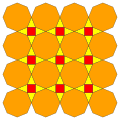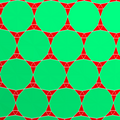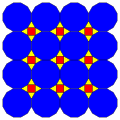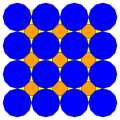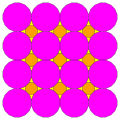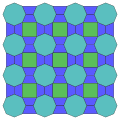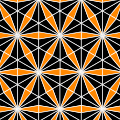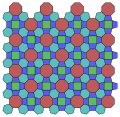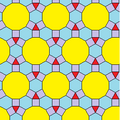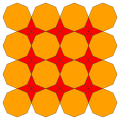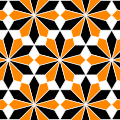Top Qs
Timeline
Chat
Perspective
Symmetrohedron
High-symmetry polyhedron From Wikipedia, the free encyclopedia
Remove ads
In geometry, a symmetrohedron is a high-symmetry polyhedron containing convex regular polygons on symmetry axes with gaps on the convex hull filled by irregular polygons. The name was coined by Craig S. Kaplan and George W. Hart.[1]


The trivial cases are the Platonic solids, Archimedean solids with all regular polygons. A first class is called bowtie which contain pairs of trapezoidal faces. A second class has kite faces. Another class are called LCM symmetrohedra.
Remove ads
Symbolic notation
Summarize
Perspective
This section may be confusing or unclear to readers. In particular, notation is neither defined nor linked to. In particular, I cannot imagine what is a "symmetric group (T,O,I)", and why a polyhedron that contains pentagons does not contains a five in its notation. (August 2025) |
Each symmetrohedron is described by a symbolic expression G(l; m; n; α). G represents the symmetry group (T,O,I). The values l, m and n are the multipliers ; a multiplier of m will cause a regular km-gon to be placed at every k-fold axis of G. In the notation, the axis degrees are assumed to be sorted in descending order, 5,3,2 for I, 4,3,2 for O, and 3,3,2 for T . We also allow two special values for the multipliers: *, indicating that no polygons should be placed on the given axes, and 0, indicating that the final solid must have a vertex (a zero-sided polygon) on the axes. We require that one or two of l, m, and n be positive integers. The final parameter, α, controls the relative sizes of the non-degenerate axis-gons.
Conway polyhedron notation is another way to describe these polyhedra, starting with a regular form, and applying prefix operators. The notation doesn't imply which faces should be made regular beyond the uniform solutions of the Archimedean solids.
Remove ads
1-generator point
Summarize
Perspective
These symmetrohedra are produced by a single generator point within a fundamental domains, reflective symmetry across domain boundaries. Edges exist perpendicular to each triangle boundary, and regular faces exist centered on each of the 3 triangle corners.
The symmetrohedra can be extended to euclidean tilings, using the symmetry of the regular square tiling, and dual pairs of triangular and hexagonal tilings. Tilings, Q is square symmetry p4m, H is hexagonal symmetry p6m.
Coxeter-Dynkin diagrams exist for these uniform polyhedron solutions, representing the position of the generator point within the fundamental domain. Each node represents one of 3 mirrors on the edge of the triangle. A mirror node is ringed if the generator point is active, off the mirror, and creates new edges between the point and its mirror image.
Remove ads
2-generator points
Summarize
Perspective
3-generator points
Remove ads
See also
References
External links
Wikiwand - on
Seamless Wikipedia browsing. On steroids.
Remove ads





























































